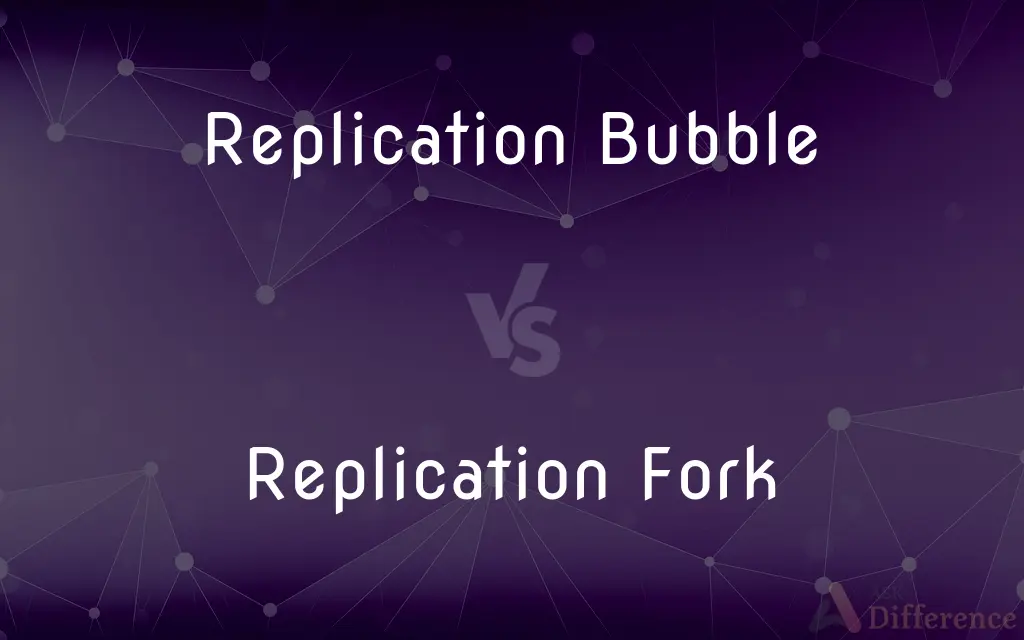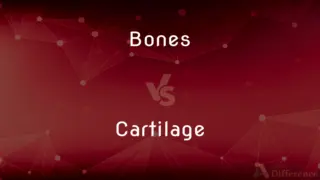Replication Bubble vs. Replication Fork — What's the Difference?
By Tayyaba Rehman — Published on January 7, 2024
A replication bubble is a region where DNA unwinds during replication, while a replication fork is the Y-shaped structure where new DNA strands are synthesized.

Difference Between Replication Bubble and Replication Fork
Table of Contents
ADVERTISEMENT
Key Differences
In DNA replication, a replication bubble is formed when the double helix of DNA unwinds at specific locations called origins of replication. This bubble creates two single-stranded DNA templates for replication. Within each replication bubble, replication forks are formed. These are Y-shaped structures where new DNA strands are synthesized by DNA polymerase enzymes.
The replication bubble serves as the overall site of DNA replication, expanding as replication progresses. It provides the necessary single-stranded DNA templates needed for replication. The replication fork, conversely, is the active area within the bubble where enzymes like DNA polymerase and helicase work to synthesize new strands of DNA, proceeding in opposite directions on the two strands.
In the replication bubble, unwinding of the DNA is initiated, and it moves along the DNA as replication proceeds. The replication fork is part of this process, advancing as the helicase enzyme unwinds the DNA double helix. Each replication bubble has two replication forks, moving away from the origin in opposite directions.
Replication bubbles are key to ensuring that DNA replication occurs efficiently and accurately. They facilitate the availability of the DNA template for the replication machinery. The replication fork, by its nature, is crucial for the actual process of adding nucleotides and forming new DNA strands.
The number of replication bubbles in a DNA molecule depends on the size and complexity of the DNA. Eukaryotic chromosomes, for instance, have multiple replication bubbles to speed up the process of replication. Each bubble, however, contains replication forks that are essential for the step-by-step addition of nucleotides to form new DNA strands.
ADVERTISEMENT
Comparison Chart
Definition
Region where DNA unwinds
Y-shaped structure for strand synthesis
Role
Site for DNA replication
Active area for new DNA strand formation
Formation
Occurs at origins of replication
Formed within replication bubbles
Number in DNA
Multiple in eukaryotic DNA
Two per bubble, moving in opposite directions
Function
Provides template for replication
Synthesizes new DNA strands
Compare with Definitions
Replication Bubble
Site of Unwinding: Where the DNA helix unwinds.
The replication bubble marks the beginning of DNA replication.
Replication Fork
Synthesis Site: Where new DNA strands are synthesized.
The replication fork is busy adding nucleotides to new DNA strands.
Replication Bubble
Expanding Structure: Expands as replication progresses.
The replication bubble grows as the forks move outward.
Replication Fork
Y-Shaped Structure: The shape of the active replication area.
DNA polymerase works at the Y-shaped replication fork.
Replication Bubble
DNA Template Preparation: Provides single-stranded DNA.
Enzymes access DNA strands within the replication bubble.
Replication Fork
Helicase Activity: Where DNA helicase unwinds the helix.
Helicase unwinds DNA at the replication fork.
Replication Bubble
Origin of Replication: Forms at specific initiation points.
Replication bubbles form at multiple origins along a eukaryotic chromosome.
Replication Fork
Bidirectional Movement: Moves in opposite directions.
Two replication forks in each bubble move away from each other.
Replication Bubble
Efficient Replication: Allows for simultaneous replication.
Multiple replication bubbles increase the speed of DNA replication.
Replication Fork
Nucleotide Addition: Site for nucleotide addition.
Each replication fork adds complementary nucleotides to the strands.
Common Curiosities
Why are there two replication forks in a bubble?
To ensure both DNA strands are replicated simultaneously and efficiently.
How does the replication fork ensure accuracy?
DNA polymerase adds nucleotides and proofreads to minimize errors.
What is the role of helicase at the replication fork?
Helicase unwinds the DNA double helix at the fork.
What initiates the formation of a replication bubble?
Specific enzymes recognize and bind to origins of replication, initiating the bubble.
Can replication bubbles merge?
Yes, adjacent replication bubbles can merge as replication progresses.
Can any part of the DNA form a replication bubble?
No, replication bubbles form at specific origins of replication.
How fast do replication forks move?
The speed varies, but it can be several thousand nucleotides per minute.
What happens to replication bubbles at the end of replication?
They merge, and the replicated DNA strands separate completely.
How many replication bubbles are in a human chromosome?
There can be hundreds to thousands, depending on the chromosome's size.
Why is it important for replication forks to move in opposite directions?
This allows for the rapid and efficient replication of both DNA strands.
Are replication bubbles present in prokaryotic DNA replication?
Prokaryotic replication typically involves a single bubble due to their circular DNA.
Does the size of the replication bubble change?
Yes, it expands as the replication forks move outward.
Are replication forks the same in all organisms?
The basic structure and function are similar, but the specifics can vary.
What happens if a replication fork stalls?
Specialized mechanisms are activated to restart or stabilize the fork.
Is the replication fork visible under a microscope?
No, it's not visible under standard microscopy due to its molecular size.
Share Your Discovery

Previous Comparison
Pyrethrin vs. Permethrin
Next Comparison
Bones vs. CartilageAuthor Spotlight
Written by
Tayyaba RehmanTayyaba Rehman is a distinguished writer, currently serving as a primary contributor to askdifference.com. As a researcher in semantics and etymology, Tayyaba's passion for the complexity of languages and their distinctions has found a perfect home on the platform. Tayyaba delves into the intricacies of language, distinguishing between commonly confused words and phrases, thereby providing clarity for readers worldwide.
















































